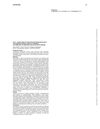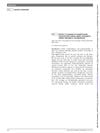 February 2010 in “Journal of The American Academy of Dermatology”
February 2010 in “Journal of The American Academy of Dermatology” The document concludes that using gadolinium-based contrast agents during MRI can be linked to Nephrogenic Systemic Fibrosis in patients with severe kidney disease.
June 2025 in “British Journal of Dermatology” Consider amyloidosis in patients with specific nail changes and check for systemic issues.
 May 2025 in “The Journal of Rheumatology”
May 2025 in “The Journal of Rheumatology” Middle-aged women with dilated cardiomyopathy should be screened for antiphospholipid syndrome.
 April 2021 in “Rheumatology”
April 2021 in “Rheumatology” An 80-year-old man with COVID-19 also had constrictive pericarditis, possibly due to an autoimmune or immunoglobulin related disease, and improved after surgery.
 March 2020 in “Poster presentations”
March 2020 in “Poster presentations” Accurate diagnosis of SLE requires extensive testing due to its complex symptoms.



